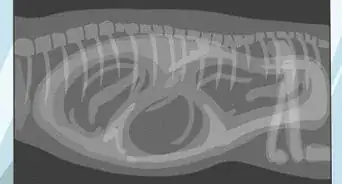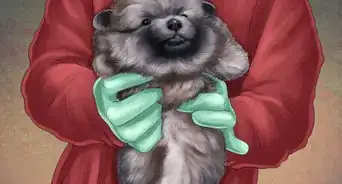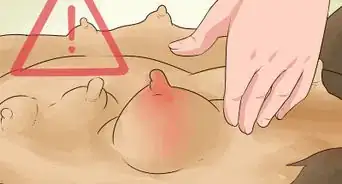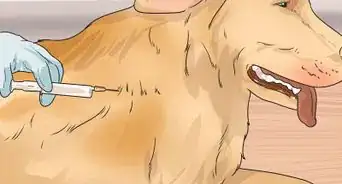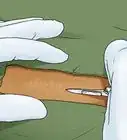This article was co-authored by April Power. April Power is a Dog Breeder and the Owner of Power Goldendoodles in Boise Idaho. She places her puppies all around the United States, specializing in breeding English Teddybear Goldendoodle puppies. In June 2020, We Love Doodles named Power Goldendoodles as one of the 9 Best Goldendoodle breeders who sell in California.
This article has been viewed 43,534 times.
Dogs typically do not deliver their young in veterinary hospitals. Home births actually decrease the risk of infection and dogs instinctively know how to deliver puppies. That being said, your dog will need to be monitored throughout the labor process in case any complications arise or human intervention is required. To monitor the stages of delivery, you should be able to identify when labor will begin, help create a nesting space, and determine when (if ever) human intervention is necessary.
Steps
Identifying when Labor will Begin
-
1Ask your vet when your dog is due. The normal gestation period for a dog is approximately 63 days (give or take 7 days) from the time of breeding. You should take your dog to the vet twenty to thirty days after breeding to determine if the dog is pregnant. A veterinarian can determine if a dog is pregnant by feeling their abdomen, conducting an ultrasound, or running a blood test. Gestation periods differ slightly depending on the breed. For example, smaller breeds will often deliver after 63 days and larger breeds may deliver before 63 days.[1]
- Ask your veterinarian to give you an approximate due date for your dog.
- Also get their on-call number so that you can contact the vet in case of an emergency during labor.
-
2Take the rectal temperature of the dog. Take your dog’s temperature once a day starting about a week or two before the due date. This will allow you to learn the normal temperature of your dog. Typically, the normal body temperature for a dog is somewhere between 99 and 102.5 degrees. This will vary depending on the size of the dog. Labor will begin within 24 hours of a drop in temperature of one degree from the dog's normal reading. For example, the dog’s temperature may drop from 99 degrees to 98 degrees.[2]
- In order to take the dog’s temperature, you can use an oral human thermometer.
- Simply lubricate the thermometer with vaseline and insert it into the dog’s rectum. Make sure it is about an inch inside and leave it there for one minute to get a proper reading.
- Take the dog’s temperature at the same time each day.
Advertisement -
3Call the vet if the stages of labour do not progress. If the dog does not enter into active labour within 24 hours of their temperature dropping, then you should call your vet. This may be a sign of a complication and you may need professional medical assistance.
Watching for Stage One Labor Signs
-
1Watch the dog’s eating habits. Prior to active labor, the dog may develop a change in eating habits. For example, on the day of whelping female dogs may not eat or they may eat and then later vomit. Although loss of appetite is fairly common, it does not happen to all dogs. Some dogs will continue to eat right up until active labor and delivery.
- A loss of appetite in the latter stages of pregnancy is likely a sign of stage one labor.
-
2Monitor restlessness in the dog. Dogs, in the early stages of labor, will also become quite restless and they may begin pacing, whining, and looking at their abdomen. This is very typical and essentially demonstrates their discomfort as they begin to experience irregular contractions. During the first stage of labor you will likely not be able to see the contractions, but the dog is preparing for delivery. This change in behavior is a clear sign that labor has begun.
- The first stage of labor can last for up to 1–2 days.
- You can comfort your dog by saying soothing words and being present.
- Avoid being overly affectionate and touchy during this stage. The dog likely wants some space.
-
3Help create a nesting space. Your dog will also begin to nest during this stage of labor. They will look for a comfortable place to deliver their puppies. This is one of the few times when you should interfere with the delivery process. You can help your dog nest by building a whelping box for them. Add lots of blankets to the space in order to make it comfortable for the laboring dog. You can also add some of their favorite toys to encourage them to use the box. Introduce the whelping box a week prior to delivery so that the dog becomes comfortable with the space.
- Place the box in a quiet, warm, and traffic-free space in your home. Do this a couple of weeks ahead of the due date, so the mother dog becomes accustomed to it.
- By helping your dog with the nesting process you can control where the delivery will take place.
- For example, you may not want your dog to deliver on your bed!
Monitoring the Dog During Active Labor
-
1Watch for abdominal contractions. As the dog transitions from the first stage of labor to more active labor, you will begin to notice contractions. This stage is marked by the visible effort to expel the puppies. For instance, the female dog may get into a squatting or lying position in order to deliver the puppies.
- A normal delivery will begin after 10-60 minutes of active labour.
- If the dog does not deliver a puppy after 60 minutes there may be a complication and you should call the vet.
- Alternatively, if the mother is contracting forcefully and no puppy is born, you should call the vet.
-
2Make sure the mother cleans the pups after delivery. When a puppy is born it is encased in an amniotic sac. The mother should lick the puppy in order to break the sac and stimulate breathing. In some instances this may not happen and you will need to intervene. Using your fingers, break the sac and wipe away any fluids around the nose and mouth. Then rub the puppy’s back with a towel to stimulate blood flow and breathing.[3]
- Keep the puppy close to the mother even if you have to interfere.
- Only interfere if necessary because this is important bonding between the mother and puppy.
-
3Ensure the mother breaks each umbilical cord. Each puppy is tethered to the mother with an umbilical cord and this will need to be severed once the puppy is born. In a normal birth the mother will bite the cord and you will not need to interfere. If this does not happen, you will need to cut the umbilical cord.
- Tie a piece of dental floss tightly around the umbilical cord, about an inch from the puppy’s body.
- Cut the cord and then clot any blood using clean gauze.
-
4Ensure the dog expels one placenta for every puppy. During the delivery of the puppies, the mother will also deliver the placenta or afterbirth. This is considered the third stage of delivery, but the placentas can be expelled sporadically throughout active delivery. There will be one placenta for each puppy that is birthed. Keep track of the placenta to ensure that all of them are removed. The mother may eat the placenta after it is delivered. Some people believe this is fine and healthy, but others prefer to remove the placenta from the whelping box.
- If the dog does not deliver the proper number of placentas take them to a veterinarian. Any unborn fetuses or afterbirth could result in serious health problems for the dog.
Expert Q&A
-
QuestionHow do you tell if your dog is in the first stage of labor?
 April PowerApril Power is a Dog Breeder and the Owner of Power Goldendoodles in Boise Idaho. She places her puppies all around the United States, specializing in breeding English Teddybear Goldendoodle puppies. In June 2020, We Love Doodles named Power Goldendoodles as one of the 9 Best Goldendoodle breeders who sell in California.
April PowerApril Power is a Dog Breeder and the Owner of Power Goldendoodles in Boise Idaho. She places her puppies all around the United States, specializing in breeding English Teddybear Goldendoodle puppies. In June 2020, We Love Doodles named Power Goldendoodles as one of the 9 Best Goldendoodle breeders who sell in California.
Dog Breeder When they are within 24 hours from labor, I usually look at the whites of their eyes and usually they're a little bit bloodshot. They dig, they turn around in circles, they whine a little bit, some experience more pain than the others. They stick closer to you like they're more needy.
When they are within 24 hours from labor, I usually look at the whites of their eyes and usually they're a little bit bloodshot. They dig, they turn around in circles, they whine a little bit, some experience more pain than the others. They stick closer to you like they're more needy.
Warnings
- Your dog may not be comfortable with lots of people around during delivery. Make sure they are in a quiet space.⧼thumbs_response⧽
- Do not interfere with the birthing process, unless necessary. You may disrupt important bonding between the mom and pups.⧼thumbs_response⧽
References
About This Article
To monitor the stages of labor in a dog, keep in mind that dogs generally give birth 63 days from the time of breeding, give or take 7 days. Around this time, monitor your dog for signs of early labor, like a loss of appetite, whining, and pacing, which can last for 24 hours. Once your dog goes into early labor, wait until you see contractions or notice your dog getting into a squatting or lying position, which is a sign that it's going into active labor. If your dog is in active labor for longer than 1 hour, contact a vet. For more tips from our Veterinary co-author, like how to care for a dog during labor, scroll down!










